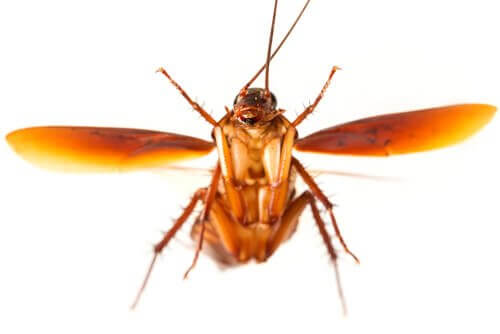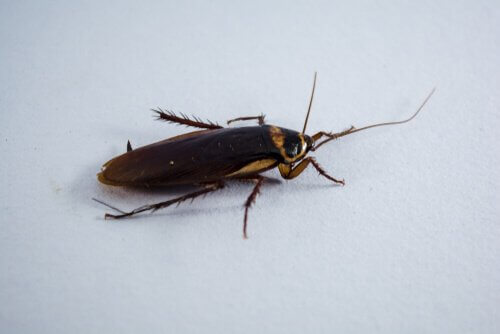We Reveal How and Why Cockroaches Fly!

We all say we’re brave…until a cockroach opens its wings and starts flying around the room! Would you like to know why and how cockroaches fly? In this article, we’ll reveal the secret!
Physical characteristics of cockroaches
To understand why cockroaches sometimes “fly”, we first have to learn a little about their physical characteristics.
Their defining physical characteristic is their body shape. It’s flat, with ends that are narrower than the center. Some species of cockroaches can measure more than 4 inches, however the body shape is the same.
As for its color, it’s dark – either black or brown. Its exoskeleton is smooth, and its thorax is well-developed. The hind legs have a type of protective “thorn”, and, in addition, it has a couple of long antennae and large eyes on the sides of its head.

Its chewing mouth device allows it to consume all kinds of foods. It has the ability to bite, and can even hurt a person with its teeth.
So…how do cockroaches fly?
These insects have wings, but strangely, most don’t use them to fly. Cockroaches have two pairs of wings. The first pair is called the fore wings, and, when they are resting, the left one rests on the right one. The second pair of wings is under the first pair, and they come out when necessary.
In reality, cockroaches don’t actually fly – they glide in an uncontrolled way! They usually open their wings when they are frightened, and try to fly in order to escape.
You might think they fly deliberately in order to attack you, but the truth is that they fly perpendicularly, and can’t control it.
During flight, each wing moves in a figure-eight pattern, so they can only fly forward. In addition, there are no flight indicators in their brains like in birds. Therefore, they have no balance or sensory receptors when they are in the air!

Which species of cockroaches fly?
Not all cockroaches have the ability to fly, even if they have wings. The ones that can surprise you by flying when they feel attacked or in danger are:
1. Surinam cockroach
It is about an inch long, and only the males can fly, and only short distances. It’s dark black, feeds on wood, and wreaks havoc on vegetation!
2. Australian cockroach
This type of cockroach is widespread throughout the world, mainly in tropical climates. It measures over an inch long as an adult, and has a yellow mark on its chest.
3. Blattella asahinai cockroach
Native to Southeast Asia, this roach is similar to the Germanic Blattodea species. It can measure around 0.8 inches, and it’s light brown.
4. Periplaneta fuliginosa (American cockroach)
Located in the southeast of the United States, this roach can measure nearly 1.6 inches long. It is one of the few species of cockroaches that can “fly” relatively well. The periplaneta is reddish-black.
5. Cuban cockroach
This cockroach isn’t just found on the island of Cuba, but also in the Caribbean and the states of Miami and Texas in the United States. Females are larger than males–one inch and 0.6 inches respectively– and both are green or yellow.
6. Megaloblatta cockroach
This roach is the real flight expert in the cockroach family. When it opens its wings, it has a wingspan of 0.8 inches wide. The wingspan is half that while resting its wings. It’s originally from Central and South America.
7. Loboptera Cockroach
This one is dark brown in color, with lighter wings and can fly quite well. However, only the males can fly, because the females have very small wings. It’s one of the most widespread species in the world.
So, now you know that cockroaches don’t exactly fly, and some species have more ability to do so than others. Try not to get scared the next time you see one spread its wings and glide toward you!
All cited sources were thoroughly reviewed by our team to ensure their quality, reliability, currency, and validity. The bibliography of this article was considered reliable and of academic or scientific accuracy.
- Pérez, J. R. (1989). La cucaracha vector de agentes patogenos. Bol Of Sanit Panam.
- Pascual, F. (2015) Orden Blattodea. Revista IDE@-SEA, 48, 1-13.
- Appel, A. G., & Rust, M. K. (1985). Outdoor activity and distribution of the smokybrown cockroach, Periplaneta fuliginosa (Dictyoptera: Blattidae). Environmental entomology, 14(6), 669-673.
- Jaramillo, G. I., Pavas, N. C., Cárdenas, J. C., Gutiérrez, P., Oliveros, W. A., & Pinilla, M. A. (2016). Blattella germánica (Blattodea: Blattellidae) como potencial vector mecánico de infecciones asociadas a la atención en salud (IAAS) en un centro hospitalario de Villavicencio (Meta-Colombia). Nova, 14(25), 19-25.
This text is provided for informational purposes only and does not replace consultation with a professional. If in doubt, consult your specialist.